Home › Forums › MGTD Kit Cars › My Project › $100 "Ols School or $1,000 Dual 40 Webers?
- This topic has 26 replies, 10 voices, and was last updated 8 years, 1 month ago by
 Royal.
Royal.
-
AuthorPosts
-
January 8, 2016 at 9:44 pm #235988
As I was building the 1641cc replacement for the 200hp, dual Dellorto 45mm carb-wielding Emma, I had to decide if I was going to stick with the stock Solex 34 PICT-3 single carb on a center manifold, or go to something more exotic and closer to what Emma had on her big engine, but more modern than the Dellorto carbs (no longer manufactured) — aka Dual Weber 40mm 2-barrel carburetors mounted directly over each head. But they were pricy. One site wanted $800 for the carbs, another $60 for shipping and $80 for set up for a VW engine…well over $1000 by the time I added the vacuum lines and fittings and a Pertronix SVDA distributor. Ouch!
So I went with the stock setup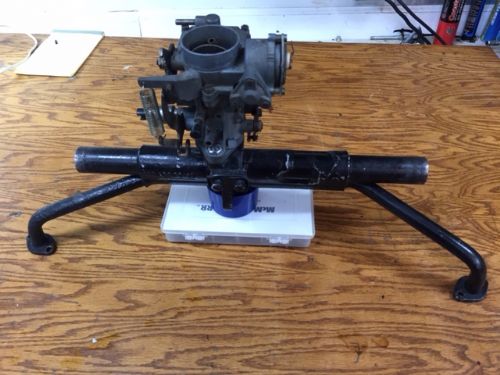 The car ran terribly — no get-up-and-go and not very smooth idle….Roy and I thought that the carb needed to be rebuilt or replaced.I just happened to have a fairly new Solex H30 PICT single barrel, center mount carburetor, so we took it off of the old single port head-style intake manifold (pre-1970/71 engines), added an adaptor to make it line up with the dual port head intake manifold on my 1974 engine, and figured we were done.Went for a test drive — Meh! Nice and average old VW feel to the car…So I started counting what $$ I had left from selling the 200 hp engine and came up quite short of the $$ needed to go with the dual Weber setup…At that point Roy, my mentor and fellow Td owner suggested I go “Old School” and try to find an old (1960’s vintage) Holley Bug spray carburetor and then make up a manifold to adapt it to the dual port head setup on the newer engine. That was at least a month ago and we are just now getting something running well — but it only cost about $100 and I now have bragging rights to a dual port 1641cc German engine using a 1960’s style American carburetor in a British replica….:-)l. to r. Solex H30, Solex H34, Holley Bug Spray all viewed from the top
The car ran terribly — no get-up-and-go and not very smooth idle….Roy and I thought that the carb needed to be rebuilt or replaced.I just happened to have a fairly new Solex H30 PICT single barrel, center mount carburetor, so we took it off of the old single port head-style intake manifold (pre-1970/71 engines), added an adaptor to make it line up with the dual port head intake manifold on my 1974 engine, and figured we were done.Went for a test drive — Meh! Nice and average old VW feel to the car…So I started counting what $$ I had left from selling the 200 hp engine and came up quite short of the $$ needed to go with the dual Weber setup…At that point Roy, my mentor and fellow Td owner suggested I go “Old School” and try to find an old (1960’s vintage) Holley Bug spray carburetor and then make up a manifold to adapt it to the dual port head setup on the newer engine. That was at least a month ago and we are just now getting something running well — but it only cost about $100 and I now have bragging rights to a dual port 1641cc German engine using a 1960’s style American carburetor in a British replica….:-)l. to r. Solex H30, Solex H34, Holley Bug Spray all viewed from the top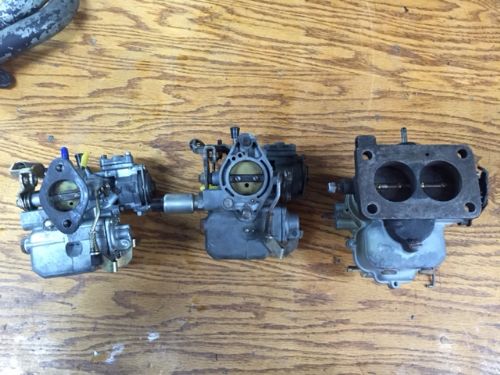 l. to r. H30; H34; Holley Bug Spray. The 30 is the size in mm of the bottom opening that the throttle plate fills, hence the H30 is 30mm, the H34 is 34mm — and the American Holley actually has 2 throttle plate openings, each 35mm. (Thanks Roy for explaining what the “34 meant in 34 PICT 3….!!!And another tidbit I came across — the PICT on the Solex carbs is the German shorthand forP= Accelerator Pump
l. to r. H30; H34; Holley Bug Spray. The 30 is the size in mm of the bottom opening that the throttle plate fills, hence the H30 is 30mm, the H34 is 34mm — and the American Holley actually has 2 throttle plate openings, each 35mm. (Thanks Roy for explaining what the “34 meant in 34 PICT 3….!!!And another tidbit I came across — the PICT on the Solex carbs is the German shorthand forP= Accelerator PumpI= Down-Draft
C= single casting
T= electric choke (thermostarter)We had to build an intake manifold that would mate up with the dual port heads so we started with an old single port manifold, cut the ends off, cut down the height so it would fit under the BCW engine cover, JB-welded everything together, added some rubber bicycle inner tube pieces, added some gaskets and clamps and voila! American carb on my fine German engine.Not pretty but it works and it was cheap….The final result — a 200 CFM Holley Bug spray on a 1641, dual port 1974-vintage engine Why you ask???…because we are retired and we can go where not many other TDr owners would even want to go — but WHAT FUN!!Oh yes — center-mount carburetors on VWs need to have heat running along side the intake manifold to keep the “loooong” intake manifold pipe from chilling due to the gas vapor/venturi effect — and causing the car to quit running. This is usually done via the small pipes coming off of the exhaust manifold on each side of the engine. But in my case, the intake manifold was so cobbled together that there was no place to get that heat pipe to contact the intake manifold.So Roy said “Maxwell House” and another innovation sprang from the mind of a great inventor…Roy, not me.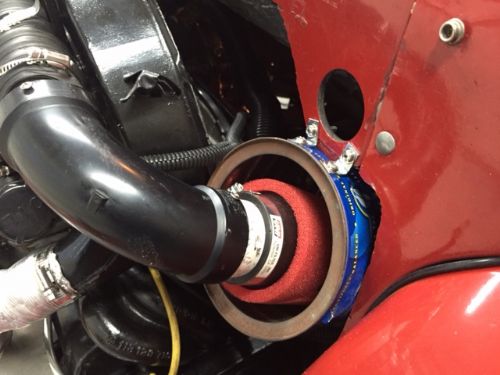 There are 2 ways to get heat to the intake — the heat tubes from the exhaust manifold — and from the heat boxes supplying cabin heat to the passenger compartment. We just went to our local Lowes’ plumbing department, picked up some 2″ plastic pipe and fittings, added a UNI filter and some dust collector hose, put it all in a 1960’s Maxwell House 3 pound coffee can that Roy was storing roofing nails in (really heavy can built out of strong metal with a metal lip on the top) and piped the hot air directly into the throat of the carburetor. I locked the passenger heat control lever full open, and put a removable cap over the heat outlet under the passenger seat. I left the driver side heat vent fully operable — I get plenty of heat for my feet….for my upper body, not so much….but that is not a change, just a “feature” of the BCW.Would I do it again, hell yes!! Was it a lot of work? Hell Yes!! Was it worth it? er…..the jury is still out…but it is definitely different and probably one-of-a-kind, especially since those Maxwell House coffee cans are so hard to find and I’m not sure if a mere Folger’s or Yuban can would work in this application.Now I just have to drive the car on a nice warm sunny day, find a nice quiet stretch of road, turn off the engine and coast to a stop, and pull out a spark plug (#2 is easiest to get to) and check for tell tales of how well the engine is jetted. Then change main jets and try again, and repeat, and repeat until I got it right…..(Roy’s plan of the day to determine proper Bug Spray Carburetor main jetting)I’ll be able to answer that “Was it worth it?” question after the jetting is sorted out (Ed’s phrase — So British — I love stealing it and using it…).I’ll let you know in about a month or 2, depending on how many nice warm sunny days I can find in Jan/Feb in Coastal North Carolina.Oh yes, on the latest test drive today (in the rain) I can report that the car is a BLAST to drive — big smile on my face, even when the passenger windshield wiper fell off and I had to pull over and run into the ditch to retrieve the wiper arm (don’t drive the car in the rain much…).As Paul said in his comments above — it’s about balance, not raw horsepower. I agree 110%— Happy JackJanuary 9, 2016 at 3:03 am #266842
There are 2 ways to get heat to the intake — the heat tubes from the exhaust manifold — and from the heat boxes supplying cabin heat to the passenger compartment. We just went to our local Lowes’ plumbing department, picked up some 2″ plastic pipe and fittings, added a UNI filter and some dust collector hose, put it all in a 1960’s Maxwell House 3 pound coffee can that Roy was storing roofing nails in (really heavy can built out of strong metal with a metal lip on the top) and piped the hot air directly into the throat of the carburetor. I locked the passenger heat control lever full open, and put a removable cap over the heat outlet under the passenger seat. I left the driver side heat vent fully operable — I get plenty of heat for my feet….for my upper body, not so much….but that is not a change, just a “feature” of the BCW.Would I do it again, hell yes!! Was it a lot of work? Hell Yes!! Was it worth it? er…..the jury is still out…but it is definitely different and probably one-of-a-kind, especially since those Maxwell House coffee cans are so hard to find and I’m not sure if a mere Folger’s or Yuban can would work in this application.Now I just have to drive the car on a nice warm sunny day, find a nice quiet stretch of road, turn off the engine and coast to a stop, and pull out a spark plug (#2 is easiest to get to) and check for tell tales of how well the engine is jetted. Then change main jets and try again, and repeat, and repeat until I got it right…..(Roy’s plan of the day to determine proper Bug Spray Carburetor main jetting)I’ll be able to answer that “Was it worth it?” question after the jetting is sorted out (Ed’s phrase — So British — I love stealing it and using it…).I’ll let you know in about a month or 2, depending on how many nice warm sunny days I can find in Jan/Feb in Coastal North Carolina.Oh yes, on the latest test drive today (in the rain) I can report that the car is a BLAST to drive — big smile on my face, even when the passenger windshield wiper fell off and I had to pull over and run into the ditch to retrieve the wiper arm (don’t drive the car in the rain much…).As Paul said in his comments above — it’s about balance, not raw horsepower. I agree 110%— Happy JackJanuary 9, 2016 at 3:03 am #266842Warning! Do not try this at home. This modification upgrade (?) Was performed by untrained reckless amateurs with too much time on their hands. (Not to mention – too much coffee.)
“Have Holley – Will travel.” (Paladin. Protector of the weak.)Royal2016-01-09 03:07:44
January 9, 2016 at 6:54 am #266843Great story on great ingenuity. I’m glad you two have the TDr’s to occupy your time. The rest of the world remains safe.
Bill Ascheman
Fiberfab Ford
Modified 5.0, 5sp., 4:11
Autocross & Hillclimb
"Drive Happy"January 9, 2016 at 11:43 am #266844Great ingenuity, yes, but aren’t you worried about what heat from the engine will do to the plastic? Are you sure it won’t catch fire or melt?johnsimion2016-01-09 11:44:19
January 9, 2016 at 12:19 pm #266845We used an old Bug Spray single port manifold that I had lying around. It had no heat risers and I was a bit concerned about carb icing. With the adaptation of the single port manifold (which we cut) to the dual port intake end pieces with the rubber boots and the upgrade to an alternator, there simply wasn’t enough space to put exhaust manifold heat risers in. I have been running a Bug Spray on my engine for a few years now and have had no problems with icing, but wanted to make sure that Jack didn’t either (I do have the manifold heat risers on my car). So, I thought that if we cannibalized some of the heat that normally would be pumped into the passenger compartment from the starboard side of the engine heater boxes, it might help prevent icing. The plumbing directs some of this heat to the intake of the carb. It does get warm, but not so hot as to be dangerous and is easy to turn off if not needed. Seems like a good work-around although he may be sacrificing 1.27% horsepower due to the fact that warm air is less dense than cold.

We’re watching it closely for now.
Royal2016-01-09 12:22:01
January 9, 2016 at 2:08 pm #266846Sounds like a “Holley”, Jolly New year!
Allen Caron
VW based 53MGTD - "MoneyPenny"
"If one thing matters, everything matters" - from the book The ShackJanuary 9, 2016 at 2:50 pm #266847GROAN —
Thanks Allen — I guess it is Holley Jolly new year — and if it turns out to be less jolly with the Holley, I can always go back to a stock carburetor — or save my pennies and then splurge on those extra fine Weber dual Carbs….January 9, 2016 at 3:08 pm #266848Great story & sounds hella fun.
I’m gonna reiterate John’s concern with using PVC pipe in an automotive engine setting. That stuff melts at about 150C. Easy to form and bend with a heat gun! So watch carefully.In case this rig gives you trouble, I have in my possession a Holley/Weber progressive intake that includes the stock heat riser provision. I suspect it’d be a cleaner base for adaptation to your Bug Spray, and you can have it for postage–or say the word and I’ll bring it to Carlisle for you.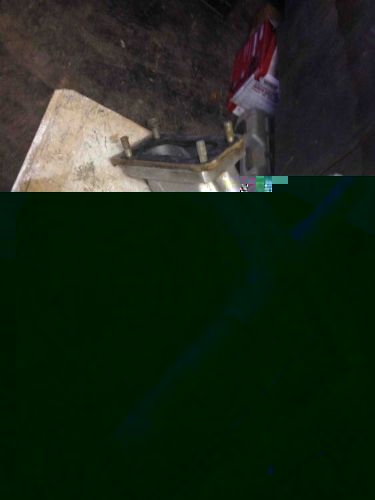 January 9, 2016 at 3:58 pm #266849
January 9, 2016 at 3:58 pm #266849Hey Ed,
I’ll PM you about that intake manifold — thanks….Good point on the PVC in the engine compartment. No issues so far, but I don’t have the engine cover and side fiberglass panels on the car yet.The PVC pipe that is probably the most vulnerable is the “drain” fitting coming off of the passenger side heater box. The air itself is not that hot, but the end of the heater box may get too warm for the PVC. I’ll have to monitor it with my little laser-pointer thermometer…The black elbow and the flex PVC connecting the Uni air filter to the carb throat should not be subjected to any high temperatures, but again, I’ll have to see how it goes once I put the cover on the back end.January 10, 2016 at 12:29 am #266850Don’t think the progressive intake will work – the carb is oriented with the barrels front to rear. The Bug Spray barrels sit side by side. It also appears to have a plenum between the two barrels. You don’t want that on a street driven Bug Spray – you’f likely have a boggy low end that you can’t tune out… A plenum under a 2 barrel gives slightly better top end but can be PITA on street cars. It works under a progressive, but individual runners give better throttle response under a normal two barrel.
Early FF TDr on 69 VW pan
Slowly coming back from the ashes...January 10, 2016 at 7:13 am #266851Thanks from the boys at VW Lab, Kent. But we knew that Ed’s manifold would not work with Bug Sprays.
We are hoping to find a Zenith carb and/or a Weber progressive to allow us to allow us to experiment and test Ed’s manifold with.
The SP manifold that we started out with here at VW Lab was a plenum type that we modified to become an isolated runner by installing a plate inside the plenum. Then we cut the arms down so that we could use it on DP heads. Since the SP manifold piping is smaller than that of a DP, we had a muffler shop make two short adapter pieces for the transition.
Other than the 2bbl manifolds installed in our test vehicles, I only have one 2bbl SP plenum type left in our inventory to experiment with.
We here at VW Lab hope to dispell and debunk some of the myths about center mounted 2bbl carbs on our small (1600 & 1641) engines concentrating our efforts on “bolt on” improvements involving no machine work to the case or the heads.
We don’t pretend to be turning over any new dirt here, but hope that some of what we write may be of some interest to some (not all). We, at VW Lab are concentrating on center mounted breathing improvements over stock.
Stay tuned for experiments with ratio rockers this spring (assuming Julie approves the grant I have applied for.)
HAVE BUG SPRAY – WILL TRAVEL
January 10, 2016 at 7:20 am #266852You boys obviously are having too much fun and will need to be separated.
January 10, 2016 at 7:36 am #266853Hey Kent,
What carbs are you running on your Tdr? Are you pleased with how they perform?Anyone else have a non-stock carb success story?January 10, 2016 at 9:15 am #266854I’m running dual 40mm Empi HPMX carbs (Weber clones) on CB Performance narrow-mount manifolds (and linkage) and a 36 HP-style doghouse fan shroud (with heat outlets) to move them closer together to fit under the engine cover. You may or may not have interference issues with the heater air tube outlets on a stock fan shroud. The 36HP style shroud is narrower.
The HPMX use Weber jets, venturies, etc and tune just like a Weber so parts and tuning info are readily available. It’s getting hard to find real Italian Webers (most are Spanish made) and the HPMX knockoffs are supposedly as good if not better than the Spanish Webers. Have only run them on a test stand, so don’t have them really fine tuned yet.
If you have room under the engine cover, a pair of 36mm Weber or HPMX single barrels would work well on a 1641cc. The dual 40mm Kadron singles are physically huge, and wouldn’t fit, I’m pretty positive. Dual Solexes (like used on Squarebacks and Fastbacks before fuel injection) are also a good match, but expensive and you don’t necessarily need their electric chokes on a fair weather car. Dual 28-36s are plenty of carb for a 1641.
What Scat cam are you running? A C-25? I ran that one on a 1679cc with dual 30mm (I think, that mas many moons ago) Solexes in a Karmann Ghia convertible, back in the day. It ran sweet!
Roy, if you’re going to invest in ratio rockers, I’d recommend you stick to 1.25 and avoid 1.4s. Are you running stock cam and heads? The 1.25s should be good for about 5 HP or so, with your Bug Spray. With a good exhaust, maybe as much as 8 HP. You may want to consider a solid rocker shaft kit (bought together they’re much cheaper than buying separately) to eliminate the problematic washer/clip combo. But, as long as you keep RPMs below 5200 or so, stock shafts with ratio rockers should be fine. Without a longer cam duration, you should be fine. If Jack was considering adding them to his cam, I’d certainly recommend solid shafts, and check for valve spring binding. Ratio rockers work best with cams designed for them due to ramp design… But, 1.25s can be a good bolt-on boost for a stock cam/head combo.
FYI, my 1679cc also has 40×35 heads with larger ports, high flow heater boxes (basically a J-tube enclosed in a heater box skin) and Engle 110 cam, so there’s definitely enough potential flow to handle dual 40s with the smallest venturies for them. With stock sized valves, I think 40s would be too much, without some agressive porting/Polishing. Again, I think 30-36mm would give much better throttle response,
Glad to see you two mad scientists experimenting! I personally love smaller, “mouse motors” that can run a bit higher RPM, as compared to larger displacement lower RPM engines. Sportier cars have traditionally run smaller, higher revving engines. As you’re likely aware, carb sizing/tuning is a real balancing act. For throttle response you want smaller sizes with high velocity airflow. For max power, you want max volume of flow. That’s why progressives theoretically work so well. Off-idle bog/stumble is sticky part of bigger carbs, like the Bug Spray – or Webers/Dellortos too big for the engine…KentT2016-01-10 09:42:06
Early FF TDr on 69 VW pan
Slowly coming back from the ashes...January 11, 2016 at 6:33 am #266855Kent, I tried to fit dual carbs under my engine cover a couple of years ago. Simply won’t go under a Daytona cover which is about 1-1/2″ too narrow for the most compact rig I could find. That’s why I decided to go Bug Spray. Thought about progressives, but everyone has them (what’s the fun there?). And I got a good deal on three manifolds and two Bug Sprays. As usual, I enjoyed my uniqueness for a while, but we cut up and modified one of my old manifolds for Jack’s TDr and he has my old “spare” carb.
Thanks for the ratio rocker opinion, a discussion which I opened in a new thread.January 11, 2016 at 8:04 am #266856Just a reminder: Jack’s car’s bodywork has been modified to fit an engine that ran something like dual 44 Webers. Basically, anything you throw at it will fit under his rear gas tank.
January 11, 2016 at 9:15 am #266857I keep having to remind myself of how much “fun” I’m having trying to get this 1641 to accept its “new” old carb setup…
Life with Emma was sure easier with the stock Solex. But once touched with the seat-of-the-pants feel of being able to goose the throttle and actually be pushed back in the seat, its hard to go back to stock…But we keep running into little files in the ointment like broken spark plug wire ends, bad coil (low voltage output and very weak spark) and a bad venturi on the right side of the carb which forced too much gas into cylinder #1 and #2, fouling plugs no matter how we adjusted that side of the Bug Spray Carburetor.Oh yea, I had mis-read the carb rebuild sheet and the float level was off just enough, causing surging and over all lousy idle speed control (float level allowing too much fuel into the bowl, we think)…Now the car runs really great at speed but won’t start when cold (float level setting now allowing too little fuel into the carburetor bowl) It takes a really loooong crank to get it to start after shutting it off, even for a few minutes —This carb sorting game (as well as the engine rebuilding hangers-on issues) is a real stretch for the impatient, “want it to work NOW” little British Car (replica) owners like me……so far I’m staying the course, but it gets harder with every fly we find in that ointment.I’m being told it is still worth the effort to be one of the Tdr owner swimming upstream…but that stock Solex carb on the self in the garage is starting to sing loud and clear “PPick me, PPick me”January 11, 2016 at 9:27 am #266858Good point, Ed. I’d suggest dual 36 singles for Jacks 1641 then. Kadrons are wider than Webers, and are very tight in a Bug, but fit well in a KG or Bus. I have no idea how they’d fit his BCW.
The only real knock on the 36s is that they didn’t use separate bronze/brass bushings on the butterfly shafts so the casting would wear and start leaking after many miles of use. A new set, with intakes and breathers are about 1/2 the price of a set of new 40s or 44s.
Early FF TDr on 69 VW pan
Slowly coming back from the ashes...January 11, 2016 at 10:09 am #266859Hey Kent,
You had asked about the cam in the 1641 —I installed a SCAT cam kit that included the cam, cam followers, and valve springs:C15-20050 – SCAT BRAND – COMPLETE PERFORMANCE CAM KIT – ALL 1600CC BEETLE STYLE ENGINES – .320 INCH LIFT AT LOBE / 277 DEGREE C20 CAM & GEAR / SINGLE HD VALVE SPRINGS / SCAT LIFTERS / HD RETAINERS & KEEPERSSo on top of everything else, I am not sure what effect this cam is having on my ability (or lack thereof) to get a “smooth” idle…no point of reference since the previous engine had an even more radical cam installed…January 11, 2016 at 11:10 am #266860C20 – I have no direct experience with it, though I’ve run the slightly more aggressive C25. It looks similar to the Engle W100. Mild, shorter duration, with slightly better lift than stock. Should be a good torque producer at low-medium RPMs. Interestingly, it would be a good candidate for 1.25 rockers also, especially since you went with the complete kit, including HD single springs. Something to think about down the road…
Meanwhile, as mild as it is, you certainly should be able to get it to idle smoothly below 900 RPM. There MAY be a bit of lope that you could hear, but it likely wouldn’t be noticeable unless idling real slow…
Early FF TDr on 69 VW pan
Slowly coming back from the ashes...January 11, 2016 at 1:24 pm #266861Hmm — I like the idea of trying 1.25 rocker arms — but sometime WAY down the road, so to speak…
I need to get the engine work done and the fiberglass rear deck back on the car. It looks like a RAT ROD right now — and the only ones that appreciate that look are the neighborhood teenagers who wave and cheer when I drive through the neighborhood while their parents cringe at the exhaust note…..January 11, 2016 at 2:21 pm #266862That’s FUN!!
January 11, 2016 at 6:42 pm #266863I just enjoy driving with my running mates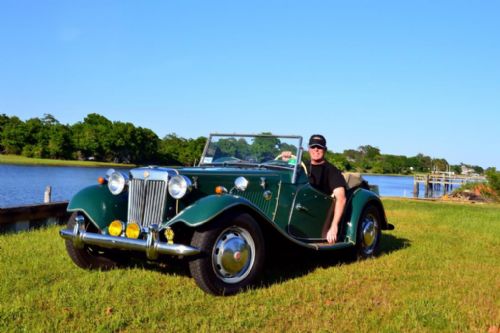 January 11, 2016 at 7:30 pm #266864
January 11, 2016 at 7:30 pm #266864I will put in a vote for Kadron/Solex duals.
I had one of mine ported for a vacuum advance Dist and in 10 years have not had a single problem other then a dropped out part I lost for awhile when I took them off to fix another problem.They just work and go and go. Can be found often for 100.00 plus a rebuild.If they fit.January 11, 2016 at 8:06 pm #266865…and from what I remember you car scoots right along like a scalded cat…..a good incentive for me trying to find and install a set of Kadrons as another option (but they are getting real hard to find….)
-
AuthorPosts
- You must be logged in to reply to this topic.
